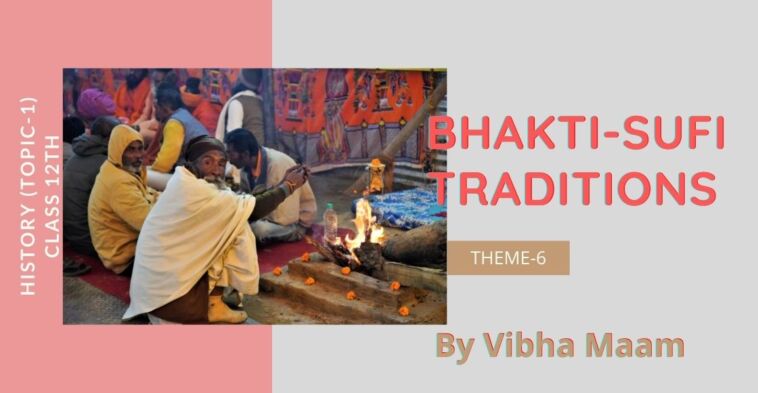Bhakti Sufi Traditions notes by Vibha Maam
Checkout handpicked notes of NCERT class 12th History Theme 6 Topic 1 Bhakti Sufi Traditions notes by Vibha Maam and don’t forget to share your valuable comments in the comment below to motivate our author.
Changes in religious beliefs and devotional texts (8th to18th century)
Religious structures:- Stupas, monastery, temples
Attributes (Characteristics) to Poet-Saints
They expressed themselves orally in regional languages.
Fluid – generations of devotees tended to elaborate on the original messages.
Historians also draw on hagiography or biography of Saints. These may not be literally accurate.
A mosaic of religious beliefs and practices
The most striking feature of this phase is the increasing visibility of a wide range of gods and goddesses in sculptures and in texts.
Major deities – Vishnu, Shiva and goddess
The integration of cults
There were at least two processes at work.
One was a process of disseminating Brahmanical ideas by composition, compilation and preservation of texts in Sanskrit
The second process was Brahman accepting and reworking the beliefs and practices of these and other social categories.
Many beliefs and practices were described by a sociologist Robert Redfield as a ‘great tradition’ and ‘little tradition’
‘Great tradition’ is practiced by dominant social categories and also by Peasants at the same time. Peasants also followed local practices but not followed by the dominant classes called ‘Little tradition’.
In this instance local deity, whose image was and continues to be made of wood by local tribal specialists was recognised as a form of Vishnu. Often simply in the form of a stone ‘smeared with ocher‘ was identified as the wife of principal deities.
Differences and Conflicts
Differences
Often worship of goddesses known as ‘Tantric’. tantric practices were widespread in several parts of the subcontinent. Tantric traditions were open to men and women. Tantric practitioners often ignored differences of caste and class, ritual context.
The ideas of this tradition influenced Shaivism as well as Buddhism. These beliefs and practices would come as ‘Hindu’ over the course of the next millennium.
The principal deities of Vedic – Agni, Indra, Soma.
The principal deities of Puranic – Vishnu, Shiva
Conflicts
Vedic tradition those who valued the Vedic tradition often condemned what went beyond the performance of sacrifices or precisely chanted Mantra, on the other hand those engaged in tantric practice frequently ignored the authority of Vedas. Devotees projected their deity as a supreme. tension between Buddhism and Jainism
Devotional worship ( Bhakti Traditions)
Expression of devotion ranged from the routine worship of deities to ecstatic state. Singing and chanting of devotional composition was often a part of such mode of worship.
There are two sect of bhakti tradition:-
Vaishnava (worship of Vishnu)
Shaiva (worship of Shiva)
Poems of Prayer
Early traditions of Bhakti
Brahmins remained important intermediaries between gods and devotees.
Accommodated and acknowledged women and lower caste.
Diversity in Bhakti tradition
Two broad categories:- Saguna bhakti (with attributes) and Nirguna bhakti (without attributes).
The Alvars and Nayanars of Tamil Nadu
The Alvars and Nayanars were considered as the founders of the Bhakti movement in South India.
Alvars:- devotees of Vishnu
Nayanars:- devotees of Shiva
They travelled from place to place singing hymns in praise of their gods.
They worshipped the saints images.
Attitude towards Caste
Both Alvars and Nayanars strongly criticized the social and religious practices prevalent in the society.
The bhakti saints came from diverse social backgrounds, even from castes considered ‘Untouchables’.
The composition of Alvars and Nayanars were as important as the Vedas.
One of the major anthologies of composition by the Alvars and Nayanars the ‘Nalariya- Divya Prabandham’ was frequently described as the Tamil Vedas.
Women Devotees
Perhaps one of the most striking features of Bhakti tradition was the presence of women.
Andal, a woman Alvar saw herself as the beloved of Vishnu.
Another woman, Karaikkal Ammaiyar, a devotee of Shiva, her composition was perceived in Nayanars traditions .
Relation with the State
From the second half of the first millennium there is evidence for States including those of the Pallavas and Pandyas (c.6th to 9th centuries CE) while Buddhism and Jainism have been drawing support from merchants and artisans communities. Tamil Bhakti opposed Buddhism and Jainism. This is particularly marked in the composition of the Nayanars.
The Chola rulers (9th to 13th centuries) supported Brahmanical and bhakti tradition, making land grants and constructing temples for Vishnu and Shiva.
Shiva temples at Chidambaram, Thanjavur and Gangaikondapuram, constructed under the patronage of Chola rulers.
Both the Nayana and the Alvars are revered by the Vellala peasants.
The Chola kings also introduced the singing of Tamil Shaiva hymns in temples under the royal patronage and compiled them into a text ‘Tevaram’.
The Chola ruler Purantaka l, had consecrated metal images of Appar Sambandar and Sundarar in Shiva temple.
Don’t forget to comment in the comment section below to appreciate and motivate our author by sharing this notes with your friends you can also Contact us for any query or if you are interested in writing with us.
Use Canva for amazing images.
Stay tuned for more amazing stories, poems & articles like this.
For sponsor any article or your article you can mail us with your logo ready and details.











wonderful notes
wonderful notes 👌
thanks maam
thanks maam
appreciable efforts maam, your notes make chapters easy and enjoyable.
I can’t believe that history is so easy .. it’s all possible because of your notes.
always guide us mam
maam iska topic -2 kb tk upload kroge
mam you are labourius ,your every notes gives me a right direction to get knowledge about the chapter
maam agla notes kb upload kroge
please 🙏🏼🙏🏼🙏🏼🙏🏼🙏🏼 v r waiting
lovely notes
Great notes mam 💕💕✨
Hii
Ho